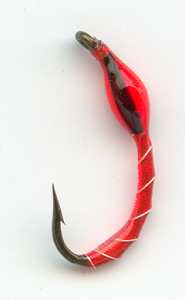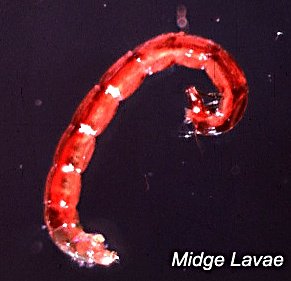Orange Ribbed Epoxy Buzzer Midge Nymph
Having fished on a variety of large lakes and reservoirs for the past 30 years I have found that the size of emerging midge buzzer nymph you tie onto your line is more important than the colour. If you are fishing with a size 10 hook and the fish are feeding on naturals that equate to a size 16 hook then you are not going to have a very productive day’s fly fishing.

EPOXY BUZZER MIDGE FLY PATTERNS. Hook size 14 12 - $US each
Many fishermen will say all you need to do is spoon a fish to find the size of emerging buzzers they are feeding on. That is great advice but how can you do that if you have not caught a trout. There is a way you can check on the current size of buzzers without having to spoon a fish. Before I get into my boat or start fishing from the bank I will go for a walk around the margins of the lake.
I work out which way the wind has been blowing and head for the bank the receiving end of that wind. I will look on the surface for emerging midge buzzer shucks. A shuck is the name given to the discarded skins or cases left behind after the aquatic nymph has emerged into the adult dun and flown away.
They are very light and often get stuck in the surface film. They get blown to the far bank and mix with other shucks until a big wave on a windy day covers them and sends them to the bottom. Studying the discarded buzzer shucks from last night’s hatch will give you the size of buzzers currently swimming in the water but not the colour.

From many years of observation and recording in my fishing diaries I have concluded that generally in March and April the buzzers are quite large and dark: either black or brown. The hooks size best suited to matching the natural insect’s size is 12 or 10. In May they remain large but are more often green in colour. In June and July they are still green in colour but have decreased in size down to an average hook size 16.
July is also the month of bloodworms where red, bright orange and claret buzzer nymphs work well. I normally use a couple of different sized epoxy nymphs and a San Juan Worm as part of a team of three flies. I use a big red bloodworm epoxy buzzer as the point fly followed by the San Juan Worm and a hook size 16 red or bright orange epoxy buzzer as the middle droppers.
A beginners guide to fishing with droppers
Smaller waters tend to have a larger turnover of stock than the larger lakes and reservoirs. The fish don’t become such free surface orientated feeders. I always chose to start fishing with a team of buzzers on these waters. I carry selection of nymphs and buzzers to match all situations I find myself fishing. You have to have the ability to be flexible in your fishing tactics.
Every year new fishing patterns come out but most of them are variations on old classic nymph patterns. I normally carry between 6 to 12 standard patterns in different sizes and colours. This covers all bases for just about any water I come across.
The secret to emerging midge buzzer fishing is not to over complicate things. If you are new to still water fishing then I would suggest that you buy patterns in black, brown, red and olive. It is far easier for the beginner to starting a team of subsurface flies with a ‘bung’ or strike indicator floating on the surface This allows for far greater control on how your flies are fishing and means you can concentrate on the take, which can be fast and vicious.
There are many dry flies that have extra buoyancy built into their design that are great for acting as the ‘bung’ fly: Adam’s Irresistible; Wulff dry flies; Hoppers; Humpy flies; Parachute dry flies, Klinkhammer flies; Goddard’s Caddis and a foam beetle.
I normally use a leader of 8lb in breaking strain. From my braided loop I have around four feet of leader to my first dropper onto which I tie the ‘bung’ surface floating fly or strike indicator. I make sure the length of the dropper is short to allow it to be able to indicate any takes on the subsurface nymphs. If the dropper length is too long there is a tendency to miss the takes.
From this fly my next three droppers are spaced roughly 3-4 feet apart. This will give the overall length of the leader as around 16 feet. This may sound short for a four fly cast but remember that if you are using a 10 foot rod your bung to point fly needs to be short enough that you are able to control and land a fish when there is a bend in the rod.
Your second option if you are a more confident still water fly fisherman is to fish your subsurface nymphs ‘straight lined’, without a strike indicator surface fly. I still keep a 3-4ft gap between the droppers but leave a 7-8ft length of leader between the first dropper and the braided loop. Always have the heaviest fly pattern as the point fly as it makes it easier to cast a team of flies.
With both of these methods the flies can either be fished static or with a very slow retrieve to mimic the natural movement of the aquatic insects you are trying to imitate. Do not be tempted to fish your flies too quickly. Buzzers do not move very fast. The trout will get spooked if your flies start to move unnaturally fast. In the middle of your slow retrieve take a very long draw of line and stop. This will lift your flies up in the water and allow them to flutter down again just as the natural insect would behave. This is when I find I get the most takes so be prepared to raise your rod tip and set the hook when you get a nibble.




Fly Fishing books

